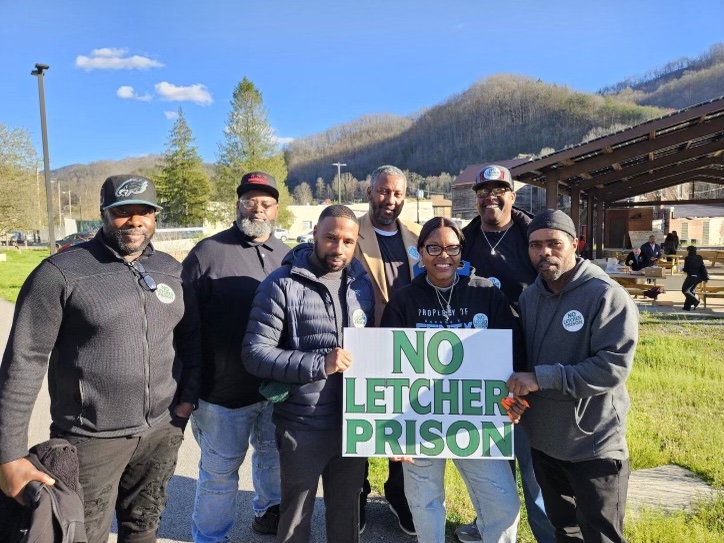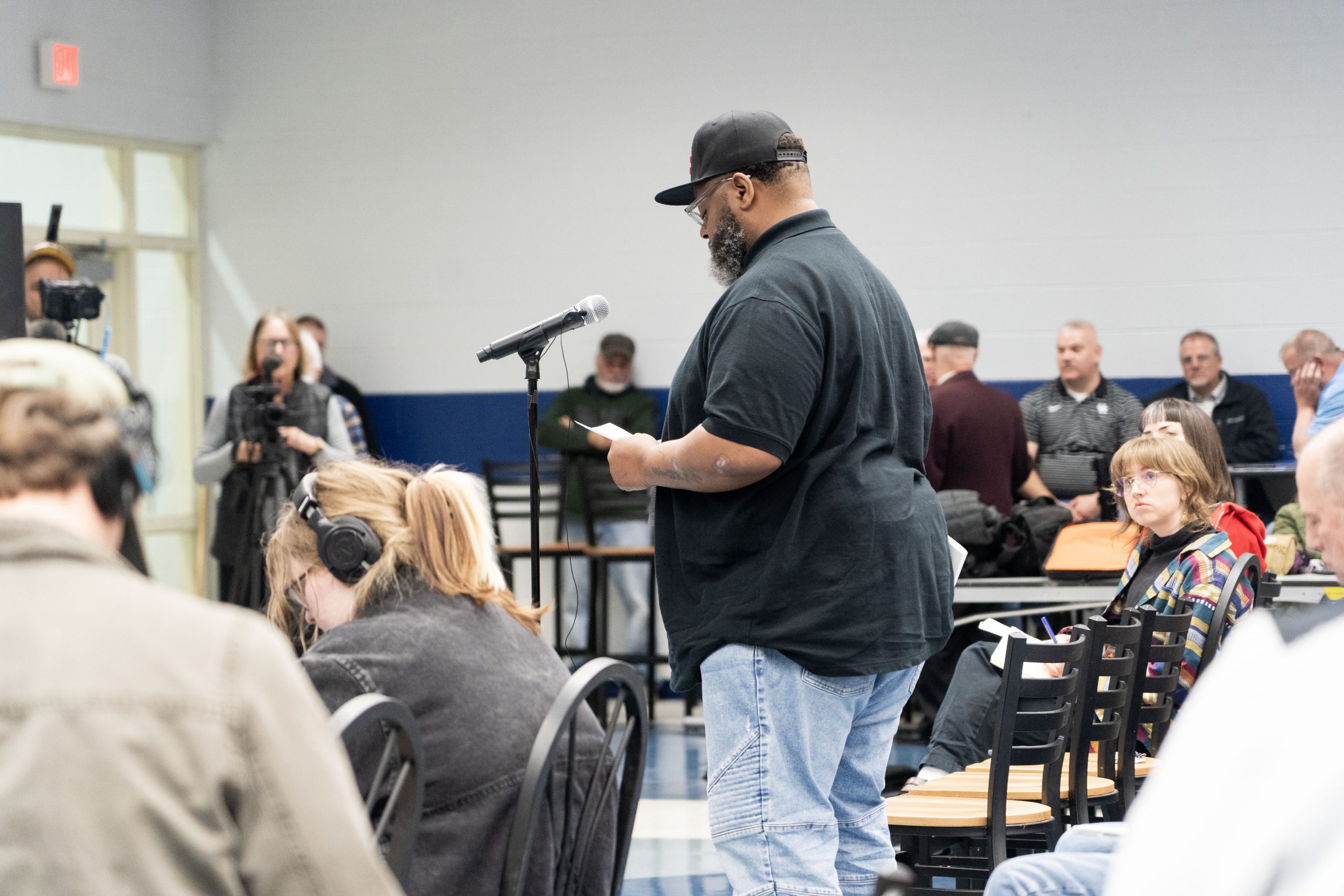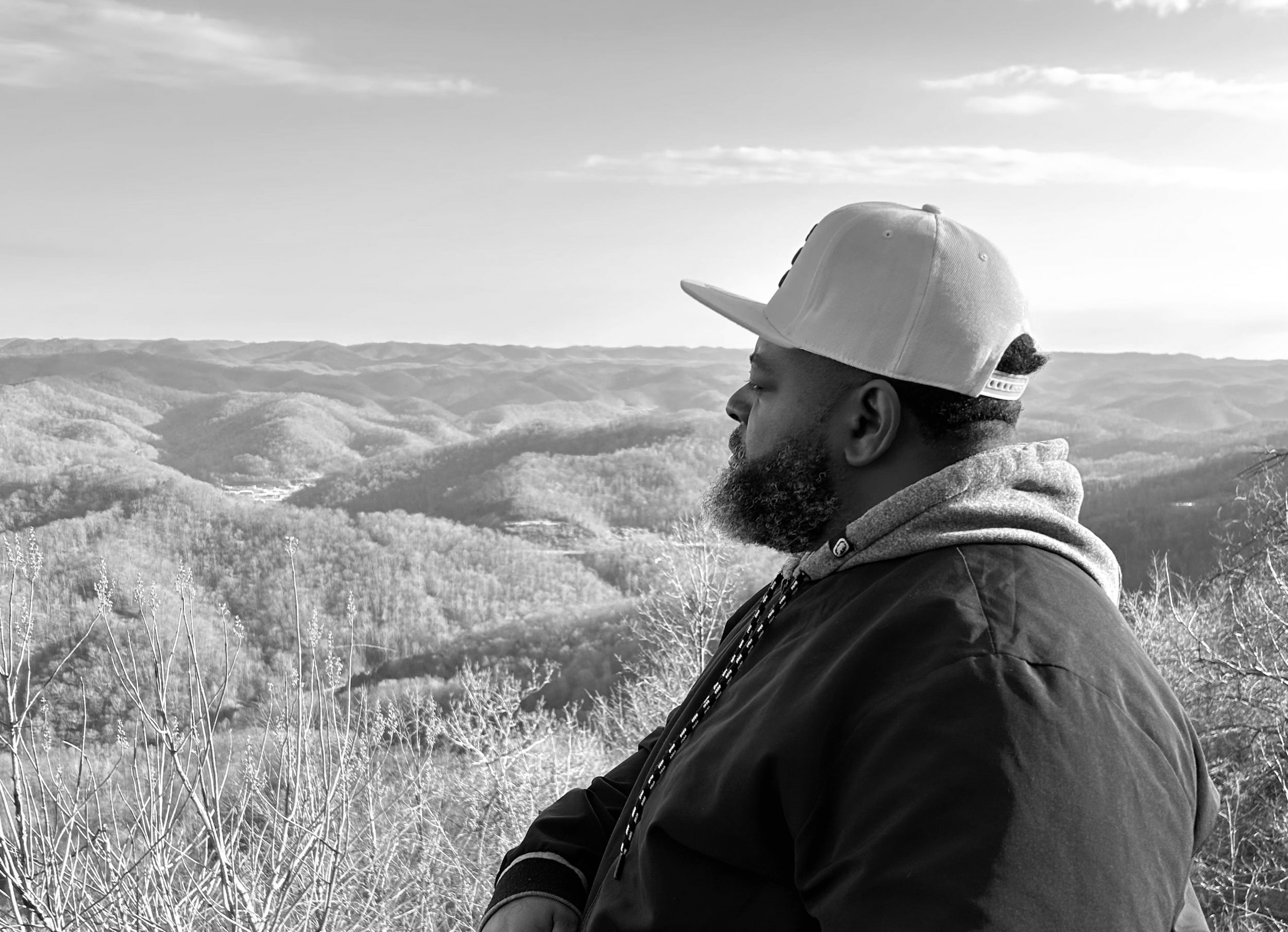When being transported to prison, Cinquan “Umar” Muhammed said, most people try to take their mind off things through chatter. But he’s a quiet person, and in the nearly thirty years of his life he spent being shuffled between federal penitentiaries in rural mountain communities, he said he preferred to take the time he had outside the barbed wire to look out at the leafy wilderness that lined the road to his cell.
During the last week of March, however—and only seven months since his release from prison—he for once came to the mountains of his own free will, together with a small crew of other formerly incarcerated people. They drove together in a large van from their homes in the Washington, D.C., area to the site of a proposed new federal prison in Letcher County, Kentucky.
“Driving here, somebody asked me: ‘Are you nervous?’” Muhammed said. The beautiful geography concealed something uglier, he knew. Behind the shelter of the woods, dusty, flat strip mines squatted on sheared-off mountaintops. And on top of many of those mountaintops was now the concrete of the very prisons where he and many of his fellow travelers had languished for decades. “You’re remembering those many times over the years coming in over the mountains, knowing that your final destination is prison.”
Muhammed and the others, all members of a writing workshop and book club through Free Minds, a D.C.-based nonprofit, came to speak to the community in an effort to warn them of what lay in store should the prison be built. This was the latest strategic move in a long-term, Letcher County–led campaign to put a stop to the project.
The prison was first proposed in 2006. It was stopped once in 2019 through a combination of environmental lawsuits, local opposition, and federal ambivalence about the project. But it was revived in 2022, though downgraded from a high- to medium-security correctional institution and prison camp. The price tag has increased, too: it is now budgeted to cost $500 million to construct. Its main cheerleader is Hal Rogers, the Kentucky congressman who has secured his astonishingly long electoral career in part by earmarking massive quantities of federal funds for roads, prisons, and post-9/11 securitization in his home state.
More from our decarceral brainstorm
Every week, Inquest aims to bring you insights from people thinking through and working for a world without mass incarceration.
Sign up for our newsletter for the latest.
Newsletter
At its currently slated cost, FCI–Letcher would be the most expensive U.S. federal prison ever built, to be constructed upon the literal and figurative wreckage of the coal industry. Its proposed site, a former mountaintop removal site in the unincorporated community of Roxana, is in a region that has been left in poverty despite the immense wealth coal generated for the mine-owner class. In addition to economic free fall, the area is facing the consequences of coal in the form of water contamination and extreme flooding. Indeed, in the summer of 2022, thirteen counties in eastern Kentucky suffered deadly floods and mudslides, but their effect was particularly acute in Letcher County. In the immediate aftermath, while residents languished at an all-time low, the federal Bureau of Prisons (BOP) quietly resurrected the Letcher prison project, at a moment when locals were feeling uniquely vulnerable and in need of aid.
Muhammed and the others thus made their long trek to impress upon Letcher County’s residents that the prison would only make local people more vulnerable. The toxic environment within the prison—and the poor environmental conditions outside of it—link the community and the incarcerated people behind the prison walls. Or, more accurately, those inside and outside of the prison are in actuality a single community, with tens of thousands of members, those inside far outnumbering the people outside. The prison endeavors to make those in the prison invisible—out of sight, out of mind—but incarcerated people remain deeply present in the hearts of their families thousands of miles away.
The BOP released its draft environmental impact statement in early March, nominally to assess any potential environmental problems that might impede the prison. Following the draft’s release, the BOP scheduled for the evening of March 28 one of the only public-listening sessions it will host as part of the prison-building process.
The meeting was held in the fluorescent-lit blue-and-white cafeteria of Letcher County Central High School in Whitesburg, the nearest incorporated town to the prison’s proposed site. It was presided over by BOP officials, and it was standing room only. The prison’s supporters had arrived early to sign up to comment, and so the first half of the meeting—nearly two hours of comments—was overwhelmingly dominated by those speaking in favor of FCI–Letcher. The shadow of ecological tragedies hung heavy over their words, as they spoke of mass coal-industry layoffs and the devastation of the 2022 floods. Again and again, people repeated like a mantra, “We need the jobs.”
As the meeting passed its halfway mark, the balance began to tip, as those who’d come to speak in opposition to the prison finally had their turn. Joshua Boyer, who had carpooled with Muhammed from D.C., seemed to recognize the true theatrics of the public comment session—that through the mic, it was a time for him and other formerly incarcerated people to speak frankly to the residents of Letcher County about what was in store.
Turning to the crowd, Boyer urged those present to ask for better than they were being offered. “Let us channel this energy into industries that uplift communities, education, renewable energy, or tourism,” Boyer said, and then called for solidarity. “These are investments to create lasting opportunities and jobs rooted in a sustainable future. Let’s demand better, not just for Letcher County, but for all communities striving for a more hopeful future.”

Boyer, Muhammed, and the other men who’d driven from D.C. were nearly the only Black people in the room. This ratio echoed the stark racial dynamics of the region: prison facilities almost completely populated by people of color, overseen by an often entirely white staff and enveloped by almost entirely white counties. These men and women had driven eight or nine hours to be here, to deliver the only testimony that would be offered that night from people who’d actually been incarcerated in an Appalachian prison. In fact, many of them had spent decades of their lives in neighboring counties—and yet, in the eyes of many in attendance, they were still outsiders.
The faces that stared back at Boyer were mostly stony, though some looked less certain of themselves than before. Some people left—maybe tired, maybe unwilling to listen—as Boyer and others described the conditions of the prisons they had been in, prisons just like the one proposed for Roxana.
When Muhammed took the mic, he described the toxic conditions of USP Big Sandy, about two hours away in Martin County, Kentucky. Big Sandy—itself the most expensive federal prison ever built at the time it opened in 2003—rests lopsidedly on a former mine site. It’s acquired the nickname “Sink-Sink” for its subsidence into the softened and fractured ground beneath it. The prison, despite official promises to the contrary, did not improve matters in the water district. It did the opposite; the immense amount of water pressure needed to pipe drinking water uphill to the prison, and channel waste away from it, has contributed to regular loss of water pressure and service to the rural communities beneath. And after all that, the water inside Big Sandy isn’t even safe, thus exacerbating already unsanitary and moldy conditions. Guards refuse to drink it, bringing their own gallons instead, but many of those incarcerated in the prison can’t afford bottled water. Many of Muhammed’s cellmates suffered from various stomach upsets and health ailments.
“I never drank water coming out of the faucet because it was always different colors,” he said. “I was fortunate. . . . I worked so I kept a few dollars on my account,” making it possible for him to purchase bottled water from the prison’s commissary. He’d always try to have a few cases on hand at any time in case of lockdown.

This is a plight that those inside of the prisons suffer alongside those in the surrounding communities. In 2000, only a few years before USP Big Sandy opened, the county in which it is sited, Martin County, suffered a coal slurry spill which contaminated the county’s water supply with arsenic, lead, and mercury. Since then, after loss of significant county revenue due to the coal industry’s abrupt collapse, the water pipes have aged rapidly without any funds to fix them.
Residents of Martin County and Letcher County have among the highest cancer rates in the country. Letcher County’s surface waters and municipal water alike are highly contaminated. Even the city water, which would presumably be piped into FCI–Letcher from Whitesburg, contains high levels of what are called disinfectant byproducts—trihalomethanes and haloacetic acids—which are formed when high volumes of water treatment chemicals come into contact with dirt and algae. Due to the dilapidated state of many of eastern Kentucky’s water pipes, earth tends to seep in through the cracks, requiring extensive treatment. These chemicals are carcinogenic and can be absorbed through the skin, inhaled, and consumed through drinking water. In other parts of the region, heavy metals and E. coli infiltrate the water system. Many eastern Kentuckians have grown to mistrust their tap water, with people in particularly rural areas often spending disproportionate amounts of small family incomes on store-bought water, or else exposing themselves to the risks.
It’s not as though FCI–Letcher’s supporters—most notably the Letcher County Planning Commission, a group of local business and civic leaders which champions the prison—are in complete denial. It’s something more complicated. There was an air of melancholy to even the strongest pro-prison comments, if you listened hard enough. Even the prison’s biggest public cheerleader, a Roxana preacher named Elwood Cornett, admitted he’d rather see something more restorative—but those alternatives simply aren’t being offered, so this is what Letcher County gets and they ought to be grateful for it. Others described children who had moved far away, hoping in earnest that the promised prison jobs—as violent and traumatic as they are—would bring them home. This is despite the fact that, by the BOP’s own admission, most people from Letcher County are unlikely to qualify for jobs at the prison, given lack of education, inability to pass a fitness exam, age, or drug and criminal history.
Still others hearkened back to the flood. Even acknowledging that a local economic boom was an unlikely outcome, many nonetheless clung to the hope that prison employees would at least buy houses and groceries and other goods here, speeding up the recovery.
The wreckage left in eastern Kentucky by the coal industry has made the landscape vulnerable to disaster, and it will make the prison toxic both to its inhabitants and its neighbors alike. This follows the grand tradition of prison-building: almost a third of prisons are built within three miles of a hazardous waste site. Strip mines contain high levels of toxic contaminants, all broken up by the mining process and then dumped back on the mountain. Nickel, arsenic, even silica, which itself causes a debilitating lung condition (silicosis) and exacerbates others, including black lung. Though decades of mine reclamation has kept this somewhat contained, prison construction threatens to dislodge it, sending plumes of dust across the old-growth forest. The streams in the region run red with oxidized metal. The draft environmental impact statement refuses to engage with any of this, saying simply, “Water quality of the streams near Roxana has not been assessed by the U.S. Environmental Protection Agency.”
University of Kentucky public health researcher Beverly Anne May, a native eastern Kentuckian who has been fighting the prison since it was first proposed, pointed out that the EPA hasn’t even tested for radon, a radioactive element. “The people who are incarcerated there would be incarcerated sometimes for decades and potentially exposed to a potent carcinogen and [have] no way to get away from it.”
May has mapped out the link between coal mines and extreme flooding, finding that 2022 flood deaths were concentrated beneath eroding strip jobs and tailing ponds (bodies of water used to filter mining refuse). “Well, we know the next big flood is coming,” May said. “We just don’t know when. That means they’re going to be cut off completely. Whenever the next big flood comes the workers, the [incarcerated people], they’re going to be up the creek.”
Despite the incidence of a thousand-year flood in 2022, this year’s environmental impact statement makes the same assessment as the 2016 environmental impact statement: it looks at the hundred-year floodplain only. But the frequency of these flood events no longer lines up with terms we use for them. Hundred-year floods could soon happen annually; thousand-year floods will increase, too, with Appalachia’s vulnerability multiplied by the disrupted hydrology of coal. Slapping many tons of impermeable concrete on what were once headwaters of the Ohio River watershed will magnify the problem, giving water nowhere to go but down.
Being at the top of the mountain is no guarantee of safety, either. FCI–Letcher would itself be on high ground, but the roads that would serve as its entrance and exit flooded in 2022. If this happened again, medical evacuation or supply transport would be impossible, and history instructs that the safety of incarcerated people would be a low priority. Edward Hunter, a member of Free Minds, noted that during his time incarcerated in Florida, he and the others were put on lockdown during a hurricane as most of the correctional staff evacuated, leaving behind only a skeleton crew. “It was Category Five,” Hunter recalled in a private conversation. “We stayed in the cell all three days, and they knew the water was contaminated, but they brought you just two bottles of water per day.” He says that the water coming out of the taps was a dark brown, undrinkable.
With federal prisons so remote, and lockdowns frequently sudden and unexpected, there’s often no way for people to know the condition of an incarcerated loved one in an emergency scenario. The already extreme geographic isolation of these prisons has become abandonment and neglect in the face of climate change, with incarcerated people just an afterthought.
“Don’t let your community become just another prison county,” pleaded Muhammed, “where they torture human souls.”
There’s a strong local resistance to the prison, one that’s spent over a decade trying to win over their neighbors to the understanding that even the smallest promises from the prison’s boosters are unlikely to come to pass in a way that benefits them. This movement is made of landowners in Roxana and a mix of people from Whitesburg and neighboring counties. Landowners in Roxana know that the risk is theirs to bear.
Still, winning folks over is not easy work. The flood swept through the community, dislodging culverts, wrecking bridges, and spinning homes off their foundations. “It’s catching us at a vulnerable time,” said Roxana landowner Mitch Whitaker, who has publicly opposed the prison since 2016. “Roxana got flooded real bad, it was Noah’s flood, animals was pairing up.”
Close to 9,000 homes were damaged or destroyed by the 2022 floodwaters. Local prison supporters say that even if no one in Letcher County gets the aforementioned prison jobs, there will still be people moving to Letcher, shoring up the tax base, buying from local businesses. But the BOP is transparent: employees won’t be moving to Letcher County; thanks to flooding, there’s nowhere for them to live.
One study suggests that $600 million would fix eastern Kentucky’s post-flood housing crisis, a little more than what’s earmarked by the BOP for the prison. Build Community Not Prisons has taken this on as a rallying cry, asking why the federal government will only invest in Kentucky as an extraction site and human landfill, rather than shoring up its climate resilience and compensating people for all they’ve lost.
Roxana’s residents don’t see a wasteland. They hike the Lilley Cornett Woods, a storied old-growth forest; they’re concerned about a population of rare bats. The mine site itself has become a kind of commons over the years, a place for four-wheeling, hunting, hiking, and family picnics. It’s become repopulated with grasses and trees, deer and coyotes—proof of the possibility of recovery. It’s a place of worship, too: Kings Creek Baptist church sometimes holds services on the flat mountaintop beneath the open sky.
“I fish the river all the time,” said another landowner, a lifelong Roxana resident who asked not to be named out of concern for his family’s safety. “It’s great smallmouth stream. Deer hunting, turkey hunting, really, really special to us and our family.” But when the prison lights and noise disrupt sleep and chase off wildlife, he said, “what’s gonna happen is good people gonna leave.”
It’s seemingly most in line with the goals of mine-lands restoration to just leave the place alone. In all likelihood the funding to upgrade Roxana’s water and sewer lines—nominally to benefit Roxana, and really to meet prison specs—will come partly from federal Abandoned Mine Land Reclamation Program funds. These are funds intended to enhance community safety and restore the local environment—but despite drawing on them, the prison would be under no obligation to deliver anything but basic site stability and economic investment. These mountains are now no longer useful as an energy resource, so by the logic of capital, they’re wasted space. As Judah Schept writes in his book Coal, Cages, Crisis, eastern Kentucky is seen as a trash place, fit only to be a dumping ground. The ecology of the flood is entangled in displacement, debris, wreckage. The prison would make that wreckage permanent.
One commenter, a father of a young daughter living in the Cowan community, pointed out that Letcher County ought to qualify as an environmental justice community under EPA guidelines. The designation would make the county eligible for federal community development grants. “Letcher County is on the line to again bear the environmental burden,” he said. “We’re told we don’t matter—that our place, environment, water, future, air don’t matter, except as a sacrifice for someone else’s gain.”
Those opposing the prison seem confident they can win again. Landowners such as Whitaker have refused to sell their property to the BOP for the prison site. Recently, the campaign defeated Section 219, a piece of fast-tracking legislation that would have bypassed parts of the environmental review process and removed the project from judicial oversight. Muhammed, Boyer, and other members of the D.C. carpool have promised to return and continue the conversation, to build solidarity between locals and the people incarcerated in their prisons.
Before returning home, the D.C. carpool drove up to the top of Pine Mountain, a scenic overlook, to see in a new light the geography that had isolated them for so many years. In the chilly air shortly after sunrise, the fog was still interlaced with the thick and dense tree canopy, but they could finally see it: all of Letcher County below, the forested sandstone hills just beginning to show spring growth, the little houses along the hollers and creek beds, without barbed wire or armed guards. The sky that Muhammed fixated on in his cell, no longer just a tiny square of blue but a wide expanse across the horizon.
Editors’ Note: Inquest is published by the Institute to End Mass Incarceration, a member of the Building Community Not Prisons coalition that is working to stop the construction of FCI–Letcher. The Institute helped to organize the trip to Letcher County described above; its Executive Director (& Inquest’s Coeditor-in-Chief), Premal Dharia, serves on the board of directors for Free Minds. Through Monday, April 15, Building Community Not Prisons is asking everyone who cares about this issue to submit a written public comment to the federal Bureau of Prisons stating their opposition to FCI–Letcher.
Header image: Cinquan “Umar” Muhammed overlooks Letcher County, Kentucky, during a visit to advocate against the construction of a new federal prison. (Image: Kandia Milton)

